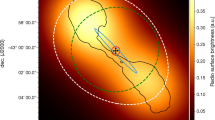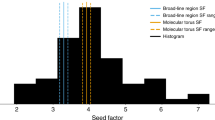Abstract
For the interpretation of X-ray radiation from kiloparsec jets of quasars, the inverse Compton scattering of the cosmic microwave background has been widely used for almost 20 years. A recent analysis of the Fermi-LAT observational data showed that this assumption is inapplicable for jets of several quasars. In this paper, we consider the inverse Compton scattering of photons from a central source as a possible mechanism for the formation of X-ray radiation from kiloparsec jets of the quasars PKS 0637–752, 3C 273, PKS 1510–089, and PKS 1045–188. Estimates of the angle between the line of sight and the velocity of kiloparsec jets are obtained. The predicted gamma-ray flux for all objects turned out to be below the upper limit on the flux from a kiloparsec jet obtained from the Fermi-LAT data. It is shown that our assumption about the mechanism of X-ray radiation from kiloparsec jets is consistent with all data of multiwavelength observations available to date.















Similar content being viewed by others
Notes
\(\Delta {\text{PA}}\), \({{\theta }_{{{\text{pc}}}}}\), and \(\theta _{{{\text{pc}}}}^{{{\text{kpc}}}}\) in [25] are denoted as \(\eta \), \(\theta \), and \(\zeta \), respectively.
The nomenclature reflects the belonging of the knots to the jet located west of the core and their angular distance from the core.
Here, we adhere to the nomenclature of knots used in [58].
Note that we do not distinguish the region located between the knots A and B2 as a separate knot, since it has a low intensity at all observed frequencies and the position of its peak brightness strongly depends on frequency. This behavior requires additional explanation, which is beyond the scope of this work.
REFERENCES
D. A. Schwartz, H. L. Marshall, J. E. J. Lovell, B. G. Piner, et al., Astrophys. J. 540, 69 (2000).
D. E. Harris and H. Krawczynski, Ann. Rev. Astron. Astrophys. 44, 463 (2006).
F. Tavecchio, L. Maraschi, R. M. Sambruna, and C. M. Urry, Astrophys. J. 544, L23 (2000).
A. Celotti, G. Ghisellini, and M. Chiaberge, Mon. Not. R. Astron. Soc. 321, L1 (2001).
G. Chartas, D. M. Worrall, M. Birkinshaw, M. Cresitello-Dittmar, et al., Astrophys. J. 542, 655 (2000).
R. M. Sambruna, J. K. Gambill, L. Maraschi, F. Tavecchio, R. Cerutti, C. C. Cheung, C. M. Urry, and G. Chartas, Astrophys. J. 608, 698 (2004).
H. L. Marshall, D. A. Schwartz, J. E. J. Lovell, D. W. Murphy, et al., Astrophys. J. Suppl. 156, 13 (2005).
B. S. Hogan, M. L. Lister, P. Kharb, H. L. Marshall, and N. J. Cooper, Astrophys. J. 730, 92 (2011).
H. L. Marshall, J. M. Gelbord, D. A. Schwartz, D. W. Murphy, et al., Astrophys. J. Suppl. 193, 15 (2011).
H. L. Marshall, J. M. Gelbord, D. M. Worrall, M. Birkinshaw, et al., Astrophys. J. 856, 66 (2018).
E. T. Meyer, M. Georganopoulos, W. B. Sparks, L. Godfrey, J. E. J. Lovell, and E. Perlman, Astrophys. J. 805, 154 (2015).
E. T. Meyer and M. Georganopoulos, Astrophys. J. 780, L27 (2014).
M. S. Butuzova, Astron. Rep. 60, 313 (2016).
A. Atoyan and C. D. Dermer, Astrophys. J. 613, 151 (2004).
F. A. Aharonian, Mon. Not. R. Astron. Soc. 332, 215 (2002).
Y. Y. Kovalev, K. I. Kellermann, M. L. Lister, D. C. Homan, et al., Astron. J. 130, 2473 (2005).
M. S. Mikhailova, E. Y. Bannikova, and V. M. Kontorovich, Astron. Rep. 54, 481 (2010).
M. S. Butuzova and A. B. Pushkarev, Astrophys. J. 883, 131 (2019).
L. Stawarz, L. Ostorero, M. C. Begelman, R. Moderski, J. Kataoka, and S. Wagner, Astrophys. J. 680, 911 (2008).
L. Ostorero, R. Moderski, L. Stawarz, A. Diaferio, et al., Astrophys. J. 715, 1071 (2010).
G. Migliori, A. Siemiginowska, and A. Celotti, Astrophys. J. 749, 107 (2012).
D. I. Nagirner and J. Poutanen, Single Compton Scattering (Harwood Academic, Amsterdam, 1994).
D. I. Nagirner and J. Poutanen, Astron. Astrophys. 379, 664 (2001).
D. I. Nagirner, Astron. Lett. 20, 358 (1994).
J. E. Conway and D. W. Murphy, Astrophys. J. 411, 89 (1993).
B P. G. Edwards, B. G. Piner, S. J. Tingay, J. E. J. Lovell, J. Kataoka, R. Ojha, and Y. Murata, Publ. Astron. Soc. Jpn. 58, 233 (2006).
P. Kharb, M. L. Lister, and N. J. Cooper, Astrophys. J. 710, 764 (2010).
M. L. Lister, D. C. Homan, T. Hovatta, K. I. Kellermann, et al., Astrophys. J. 874, 43 (2019).
E. Komatsu, J. Dunkley, M. R. Nolta, C. L. Bennett, et al., Astrophys. J. Suppl. 180, 330 (2009).
D. C. Homan, M. L. Lister, Y. Y. Kovalev, A. B. Pushkarev, T. Savolainen, K. I. Kellermann, J. L. Richards, and E. Ros, Astrophys. J. 798, 134 (2015).
J. F. C. Wardle and S. E. Aaron, Mon. Not. R. Astron. Soc. 286, 425 (1997).
T. G. Arshakian and M. S. Longair, Mon. Not. R. Astron. Soc. 351, 727 (2004).
L. M. Mullin and M. J. Hardcastle, Mon. Not. R. Astron. Soc. 398, 1989 (2009).
T. J. L. Courvoisier, Astron. Astrophys. Rev. 9, 1 (1998).
M. Türler, S. Paltani, T. J. L. Courvoisier, M. F. Aller, et al., Astron. Astrophys. Suppl. Ser. 134, 89 (1999).
A. W. B. J. Geldzahler, Astron. J. 86, 1306 (1981).
A. Wright and R. Otrupcek, PKS Catalog–Parkes Southern Radio Source Catalog, Version 1.01 (1990).
O. B. Slee, Austral. J. Phys. 48, 143 (1995).
A. Adraou, R. Chini, M. Albrecht, R. Lemke, P. A. Shaver, L.-A. Nyman, and R. S. Booth, Astron. Astrophys. 376, 1123 (2001).
M. G. Mingaliev, Y. V. Sotnikova, T. V. Mufakharov, A. K. Erkenov, and R. Y. Udovitskiy, Astrophys. Bull. 70, 264 (2015).
E. L. Wright, X. Chen, N. Odegard, C. L. Bennett, et al., Astrophys. J. Suppl. 180, 283 (2009).
B. Vollmer, B. Gassmann, S. Derriére, T. Boch, et al., Astron. Astrophys. 511, A53 (2010).
W. K. Gear, J. A. Stevens, D. H. Hughes, S. J. Litchfield, et al., Mon. Not. R. Astron. Soc. 267, 167 (1994).
T. Hovatta, E. Nieppola, M. Tornikoski, E. Valtaoja, M. F. Aller, and H. D. Aller, Astron. Astrophys. 485, 51 (2008).
M. Moshir, G. Kopan, T. Conrow, H. McCallon, et al., The IRAS Faint Source Catalog, Version 2 (1990).
C S. J. Tingay, D. L. Jauncey, E. A. King, A. K. Tzioumis, J. E. J. Lovell, and P. G. Edwards, Publ. Astron. Soc. Jpn. 55, 351 (2003).
A. M. Burgess and R. W. Hunstead, Astron. J. 131, 114 (2006).
H. L. Marshall, D. E. Harris, J. P. Grimes, J. J. Drake, et al., Astrophys. J. 549, L167 (2001).
R. M. Sambruna, C. M. Urry, F. Tavecchio, L. Maraschi, R. Scarpa, G. Chartas, and T. Muxlow, Astrophys. J. 549, L161 (2001).
C. C. Cheung, L. Stawarz, and A. Siemiginowska, Astrophys. J. 650, 679 (2006).
K. T. Mehta, M. Georganopoulos, E. S. Perlman, C. A. Padgett, and G. Chartas, Astrophys. J. 690, 1706 (2009).
Y. Uchiyama, C. M. Urry, J. van Duyne, C. C. Cheung, R. M. Sambruna, T. Takahashi, F. Tavecchio, and L. Maraschi, Astrophys. J. 631, L113 (2005).
A. B. Pushkarev, T. Hovatta, Y. Y. Kovalev, M. L. Lister, A. P. Lobanov, T. Savolainen, and J. A. Zensus, Astron. Astrophys. 545, A113 (2012).
R. G. Conway, S. T. Garrington, R. A. Perley, and J. A. Biretta, Astron. Astrophys. 267, 347 (1993).
R. A. Perley and K. Meisenheimer, Astron. Astrophys. 601, A35 (2017).
Y. Uchiyama, C. M. Urry, C. C. Cheung, S. Jester, et al., Astrophys. J. 648, 910 (2006).
J. N. Bahcall, S. Kirhakos, D. P. Schneider, R. J. Davis, T. W. B. Muxlow, S. T. Garrington, R. G. Conway, and S. C. Unwin, Astrophys. J. 452, L91 (1995).
S. Jester, H. J. Röser, K. Meisenheimer, R. Perley, and R. Conway, Astron. Astrophys. 373, 447 (2001).
S. Jester, H. J. Röser, K. Meisenheimer, and R. Perley, Astron. Astrophys. 431, 477 (2005).
D. E. Harris and C. P. Stern, Astrophys. J. 313, 136 (1987).
H. J. Röser, K. Meisenheimer, M. Neumann, R. G. Conway, and R. A. Perley, Astron. Astrophys. 360, 99 (2000).
S. Jester, D. E. Harris, H. L. Marshall, and K. Meisenheimer, Astrophys. J. 648, 900 (2006).
S. Jester, K. Meisenheimer, A. R. Martel, E. S. Perlman, and W. B. Sparks, Mon. Not. R. Astron. Soc. 380, 828 (2007).
C. P. O’Dea, R. Barvainis, and P. M. Challis, Astron. J. 96, 435 (1988).
F. Acero, M. Ackermann, M. Ajello, A. Albert, et al., Astrophys. J. Suppl. 218, 23 (2015).
F. Massaro, D. E. Harris, and C. C. Cheung, Astrophys. J. Suppl. 197, 24 (2011).
A. A. Abdo, M. Ackermann, M. Ajello, A. Allafort, et al., Astrophys. J. 715, 429 (2010).
J. L. Gómez, A. P. Lobanov, G. Bruni, Y. Y. Kovalev, et al., Astrophys. J. 817, 96 (2016).
A. M. Kutkin, I. N. Pashchenko, M. M. Lisakov, P. A. Voytsik, et al., Mon. Not. R. Astron. Soc. 475, 4994 (2018).
S. V. Pilipenko, Y. Y. Kovalev, A. S. Andrianov, U. Bach, et al., Mon. Not. R. Astron. Soc. 474, 3523 (2018).
L. Vega-García, A. P. Lobanov, M. Perucho, G. Bruni, et al., arXiv:1912.00925 [astro-ph.GA] (2019).
E. V. Kravchenko, J. L. Gómez, Y. Y. Kovalev, and P. A. Voitsik, Adv. Space Res. 65, 720 (2020).
Y. Y. Kovalev, N. S. Kardashev, K. I. Kellermann, A. P. Lobanov, et al., Astrophys. J. 820, L9 (2016).
B. G. Piner, A. B. Pushkarev, Y. Y. Kovalev, C. J. Marvin, et al., Astrophys. J. 758, 84 (2012).
Funding
This work was partly supported by the Russian Foundation for Basic Research, project no. 18-32-00824. Within this project, for all the objects under consideration, approximations of the CS’s spectra were obtained, the density of emitting electrons and the magnetic field strength at the knots of the kpc-scale jets were estimated, the angles with the line of sight and the velocities of the kpc-scale jets were determined, and the spectrum of radiation due to IC/CS was simulated.
Author information
Authors and Affiliations
Corresponding authors
Additional information
Translated by E. Chernokozhin
Rights and permissions
About this article
Cite this article
Butuzova, M.S., Pushkarev, A.B., Shablovinskaya, E.S. et al. Inverse Compton Scattering of Radiation from a Central Source as a Possible Mechanism for the Formation of X-Ray Radiation from Kiloparsec Jets of Core-Dominated Quasars. Astron. Rep. 64, 894–914 (2020). https://doi.org/10.1134/S1063772920110025
Received:
Revised:
Accepted:
Published:
Issue Date:
DOI: https://doi.org/10.1134/S1063772920110025




